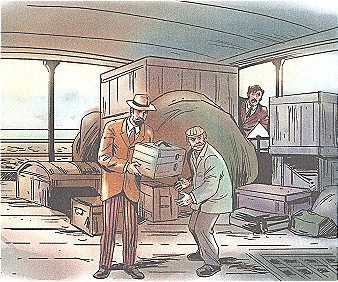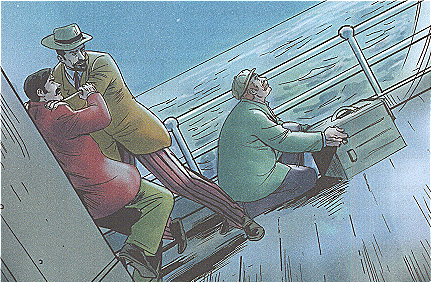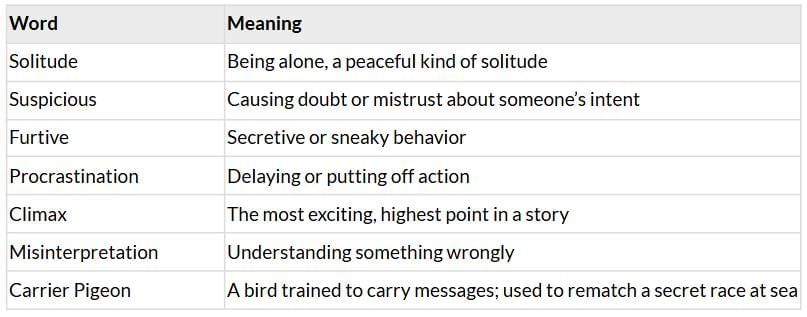That Little Square Box Chapter Notes | Gul Mohar Class 8: Book Solutions, Summaries & Worksheets PDF Download
| Table of contents |

|
| About the Author |

|
| Detailed Summary |

|
| Moral / Message |

|
| Character Sketches |

|
| Vocabulary Table |

|
About the Author
Arthur Conan Doyle (1859–1930) was a British writer best known for creating the famous detective Sherlock Holmes. Besides detective fiction, he wrote historical novels, science fiction, and short stories—like That Little Square Box—for their suspense and intriguing plots.
Detailed Summary
The story That Little Square Box by Arthur Conan Doyle is a suspenseful tale filled with mystery and a surprising twist. The narrator boards a steamer called the Spartan on his way to New York. He finds a quiet corner on the deck, preferring solitude. Soon after, two men named Flannigan and Muller board the ship. They carry with them a small, square wooden box that immediately catches the narrator’s attention.
Their secretive behaviour and hushed conversation about the box make him uneasy. They handle the box very carefully, whispering about a “trigger” and some granules that are placed inside, followed by a “clicking” sound. To the nervous narrator, it all seems like they are preparing some dangerous machine—perhaps even a bomb.
Fear takes hold of him. The more he observes the men, the more convinced he becomes that they are dangerous. He struggles with his thoughts: should he warn the Captain and risk being laughed at, or should he stay silent? His anxiety grows as he imagines the terrible consequences of doing nothing. Still, he decides to wait and watch.
Later that night, while hiding near a lifeboat, he sees the two men once again with the mysterious box. They seem to be setting it up, and he overhears something about a timer. His dread reaches its peak—he is now certain that the box is about to explode. Convinced that the lives of everyone on the ship are in danger, he finally gathers the courage to confront them and shouts at the men.
To his shock, instead of an explosion, the box suddenly opens—and two pigeons fly out! The men explain that they were secretly organising a pigeon race. Since the Captain did not allow racing on board, they had been trying to hide it from others.
The narrator feels both embarrassed and relieved. The “dangerous” square box turns out to be completely harmless. The story ends with humour after all the suspense, teaching us how fear and imagination can make us misinterpret events.
Moral / Message
The story shows how fear and imagination can make us misjudge people and situations. We often jump to conclusions without knowing the full truth. It teaches us not to be suspicious or hasty, but instead to think calmly and seek facts before reacting. Trust, patience, and clear thinking are better than panic and doubt.
Character Sketches
Flannigan
Flannigan is one of the two mysterious passengers carrying the square box. His secretive behaviour and careful handling of the box make him seem suspicious to the narrator. However, he is not dangerous at all—just enthusiastic about pigeon racing. His secrecy comes only from trying to hide the race from the Captain.
Muller
Muller is Flannigan’s companion and partner in the pigeon race plan. Like Flannigan, he also appears secretive and fuels the narrator’s suspicions. He is practical and focused on the task of preparing the box. In the end, his role highlights how innocent actions can be misunderstood when seen through fear and imagination.
Vocabulary Table

|
32 videos|62 docs|17 tests
|
FAQs on That Little Square Box Chapter Notes - Gul Mohar Class 8: Book Solutions, Summaries & Worksheets
| 1. What is the main theme of "That Little Square Box"? |  |
| 2. Who is the central character in "That Little Square Box" and what are their significant traits? |  |
| 3. What moral lesson can be derived from the story? |  |
| 4. How does the author use symbolism in "That Little Square Box"? |  |
| 5. Can you explain the significance of the ending of "That Little Square Box"? |  |














